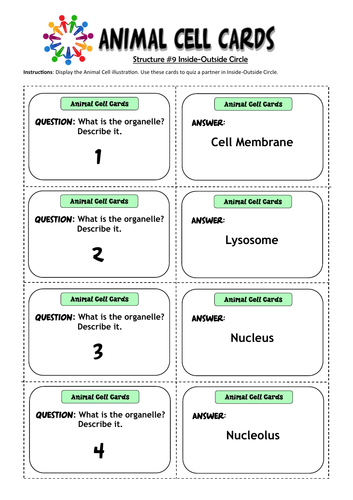

To be used with Kagan style lessons or as an active learning activity for pupil group work.
Kagan Structure number 9: Inside Outside Circle
Students rotate in concentric circles to face new partners for sharing, quizzing, or problem solving.
The teacher prepares questions or problems, or the teacher or students prepare question cards, one per student. Students form A-B pairs.
Step 1: Form the Outside Circle
Partner A from each pair moves to form one large circle in the class, facing in. “Partner A’s, please form a large circle in the open area of the classroom. B’s watch where your partner goes.”
Step 2: Form the Inside Circle
Partner B’s find and face their partners. The class now stands in two concentric circles. “Partner B’s, please find and face your partners.”
Step 3: Inside Circle Asks Question; Outside Circle Responds
Question Cards: Inside Circle students ask a question from their question card; Outside Circle students answer. Inside Circle students praise or coach.
Teacher Questions: The teacher asks a question and asks the Inside Circle students, Outside Circle students, or both (Timed Pair Share) to share with their partners. “What did you do this weekend? Everyone think. Inside Circle students please share for 30 seconds.”
Step 4: Partners Switch Roles
Outside Circle students ask, listen, and then praise or coach. “Outside Circle students, it’s your turn to share for 30 seconds.”
Step 5: Partners Trade Cards
When using question cards, partners trade cards. To indicate they are ready to rotate, the Inside Circle students turn and face the centre of the circle.
Step 6: Rotate Partners
Students face their partners, then turn to touch right shoulders. Either the Inside Circle students rotate to a new partner or the Outside Circle students rotate to a new partner. The teacher may call rotation numbers: “Face your partner. Turn sideways to touch right shoulders. Inside circle, rotate three students ahead.” The class may do a “choral count” as they rotate.
Repeat:
Students rotate and quiz many times to discuss or solve problems with different partners.
Kagan Structure #10 Rotating Lines can be used instead of concentric circles. The students stand in facing lines instead. Lines are easier for younger students, work well with smaller groups, and may work better based on your room configuration.
Something went wrong, please try again later.
This resource hasn't been reviewed yet
To ensure quality for our reviews, only customers who have purchased this resource can review it
Report this resourceto let us know if it violates our terms and conditions.
Our customer service team will review your report and will be in touch.
